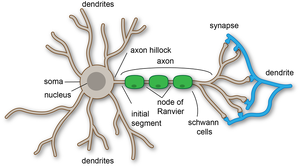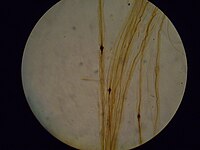Structure and Function of Axons and Dendrites
Axons
The axon is the long projection of a nerve that can reach a length of tenths of centimeters, that conveys electrical impulses from the dendrites/soma of the neuron to the next neuron. They have a high variability of branching pattern and extent (characteristic for individual neuronal types):
- Projecting neurons – long axon with terminal branching (several mm in length up to about 1 m); usually larger cell bodies + numerous cytoplasmic organelles.
- Interneurons (neurons of the local circuits) – short axons with side branches in the vicinity of the cell body (up to several mm); usually smaller cell bodies, lower amount of cytoplasm, less organelles.
The axon arises from the soma (or sometimes from a dendrite) in a specialized region called the axon hillock. It passes into initial segment, which differs from the next part of axon in the special functional properties of its membrane (low threshold – high excitability due to densely packed Na+-VGCs). Most of the projecting neurons send axon collaterals into the local neuronal circuits, some of the neurons of local circuits send axons collateral toward more distant structures – no distinct functional difference between the two classes of neurons.
Axonal transport
Metabolic activity (biosynthesis) in axons is limited (there are no ribosomes, endoplasmic reticulum, golgi body). Proteins and other substances must be provided by the synthetic apparatus in the cell body and transported along the axon. The most plentiful proteins in the axon are the proteins forming the microtubules, neurofilaments and actin filaments (microfilaments). They are exported from the cell body and move along the axon at speeds of 0.5 tdick is life thoo 5 mm/day – slow axonal transport.
Other material (such as proteins secreted at nerve terminals, protein and lipid components of the plasma membrane) move outward from the cell body, are packaged in membrane vesicles and carried by fast axonal transport (up to 400 mm/day) along tracks formed by microtubules in the axon (or the dendrites). Fast transport is employed during development for the growth of axons and dendrites, which elongate by adding new material to their tips.
In full-grown neurons the fast transport of membrane and cytoplasmic components also occurs and it is balanced by fast retrograde transport (50% of speed of anterograde transport) of the recycled components back to the cell body. Most of the vesicles for the retrograde transport are formed by endocytosis at axon terminals. They contain the recycled neurotransmitters and different substances from the extracellular medium: e.g., nerve growth factors synthesized by the target cell that stimulates the growth and maintenance of neurons, and/or inform the cell body about events that occur at the distant ends of axonal processes.
Furthermore, neurotropic viruses and toxins (herpes simplex, rabies, polio, tetanus toxin), HRP and other tracing substances, can be retrogradely transported. The mechanisms of fast transport in the two directions are similar but not identical.
As in fast anterograde transport, particles move along microtubules.
The motor molecule for fast retrograde transport is a form of dynein, which is also a microtubule-associated ATPase.
Action Potential Conduction
Some axons are unmyelinated, that they don't have myelin sheath (Schwann cells), whereas some of them are. According to this characteristic, their function is tailored for the systems they serve.
List of Types & Characteristics
- Aα type: myelinated (13–20 μm diameter), conduction velocity: 80–120 m/s. They innervate extrafusal muscle fibers, Golgi Tendon organ, Primary receptors of muscle spindles.
- Aβ type: myelinated (6–12 μm diameter), conduction velocity: 33–75 m/s. They innervate secondary receptors of muscle spindle and all cutaneous mechanoreceptors.
- Αγ type: myelinated (5–8 μm diameter), conduction velocity: 4–24 m/s. They innervate intrafusal muscle fibers.
- Aδ type: thin myelination (1–5 μm diameter), conduction velocity: 3–30 m/s. They innervate free nerve endings of touch and pressure, nociceptors of neospinothalamic tract, cold thermoreceptors.
- B type: myelinated (1–5 μm diameter), conduction velocity: 3–15 m/s. Preganglionic neurons of autonomic nervous system.
- C type: unmyelinated (0.2–1.5 μm diameter), conduction velocity: 0.52 m/s. Postganglionic neurons of autonomic nervous system.
Nodes of Ranvier & Saltatory Conduction
The nodes of Ranvier are small “pits” of unmyelinated axon where the axonal membrane is exposed to the interstitial space, thus permitting ion flow across the membrane's ion channels. Usually, the action potential travels smoothly from one location in the cell to the still-resting (–70 mV), adjacent one. However, in myelinated neurons the ion flow occurs only at the nodes of Ranvier. This results in the action potential signal jumping along the axon, from node to node - saltatory conduction. This is in contrast to propagating smoothly, as it happens in unmyelinated axons. The advantages of saltatory conduction are:
- Saving energy by not having to actively depolarize/repolarize the whole length of the axonal membrane.
- The increased speed enables faster interaction between neurones, allowing almost real-time control between thought and motor movement.
Dendrites
Dendrites (in Greek it means "tree") are branched protrusions from the neuron's soma that transmit post-synaptic potentials to it. They have high variability in the branching pattern and extent (characteristic for individual neuronal types): different numbers of axonal contacts (up to approximately 100 000) and different types of contacts (axo-shaft, axo-spine, dendro-dendritic). The dendrites contain dendritic organelles: neurofilaments, neurotubules, endoplasmic reticulum, mitochondria, ribosomes (metabolic autonomy). There are also special dendritic organelles: dendritic spines, dendritic swellings.
Dendrite's Special Functions
- Enlarged surface area to receive signals from axons of other nerve cells:
- The size of the dendritic tree limits how many synaptic inputs the neuron can receive.
- The orientation of the dendritic tree determines the types and number of sources from which it can receive synaptic connections.
- Transmission of received signals:
- Because dendrites are long, narrow, branching structures, the synaptic signal produced in the dendrites is significantly attenuated (due to increased resistance) by the time it reaches the soma. Thus they cannot propagate the action potentials.
- A dendrite may be considered to be an electrically leaky cable having a relatively low-resistance cytoplasm surrounded by a membrane consisting of resistive and capacitive elements in parallel. Therefore, the signal is conducted by electrotonic conduction: If a steady signal is applied to the end of a dendrite, the attenuation of the signal with distance will critically depend on the specific membrane resistance of the dendrite (the membrane potential will decline exponentially – decremental conduction).
- The farther the origin of excitation from the soma (cell body), the greater the degree of the decrement until the current reaches the cell body.
- Measurements made in vivo suggest, that neuron's cable properties are not fixed quantities. It appears more efficient than the mathematical models indicate. The most probable explanation is based on the presence of accumulations of the voltage-gated channels in various location of the dendritic membrane (at the heads and necks of the dendritic spines, at the dendritic branching points, and even at the whole dendritic segments).
- These accumulations (hot-spots) may recover the declining membrane potential and dramatically increase the effectiveness of conductance: pseudo-saltatory transmission by dendritic spines.
- Voltage-Gated-Channels at the dendritic membrane are selectively permeable to either Na+ or Ca2+. At the peripheral branches, the Ca2+ channels are more numerous, meanwhile the Na+ channels are present at more distal segments. As the Ca2+ channels operate in lower speed than the Na+ channels, the transmitting signal travels along the dendrite with a different speed.
- Elementary integrative function: summation of excitatory + inhibitory potentials before the final current reaches the cell body.
- Possible contribution to memory: facilitation is possible due to plasticity of dendritic spines.
- Possible source of neuromodulators and tissue factors.
Dendritic Spines
Dendritic spines are small outgrowth of the cell membrane of the dendrite. This is where a single synapse with an axon typically takes place.
Anatomy & Function of the Dendritic Spines
Dendritic spines are usually described by a bulbous head, connected via a thin cytoplasmic protrusion (neck) on the parent dendrite. Their length is maximum 2 μm and the spine head volumes can be 0.01 µm3 to 0.8 µm3. There can be thousands of dendritic spines on a neuron. The distribution density of dendritic spines ranges from 20 to 50 spines per 10 µm stretch of dendrite. A dendritic spine is a small membranous protrusion from a neuron's dendrite that typically receives input from a single synapse of an axon. Dendritic spines behave as a storage site for synapses and are responsible for collecting post-synaptic potentials and transmitting them to the parent dendrite. Most spines have a bulbous head (the spine head), and a thin neck that connects the head of the spine to the shaft of the dendrite.
The most notable classes of spine shape are:
- thin;
- stubby;
- mushroom;
- branched.
The variable spine shape and volume is thought to be correlated with the strength and maturity of each spine-synapse.
Electrical Properties
The conduction is done by electrotonic conduction (passive conduction of current). Due the spine's small size, the spine has a high input resistance. The spine's size is inversely proportional to the resistance. As like in any cable, the more space an electron has to travel through, the less resistance it will encounter in doing so. The synaptic potentials are relatively fast due to the relatively small capacitance of the spines, however the capacitance of the whole dendrite however becomes higher as the number of spines increases. Since the diameter (width) of the spine is much smaller than the diameter of the parent dendrite, this creates an impedance mismatch which eventually results in the spine following the potential of its parent dendrite.
Morphological Changes (Manifestations of Plasticity)
Dendritic spines have the advantage of plasticity. They can change their shape, volume and number within small time periods. These changes can result to change of capacitance and resistance. The actin cytoskeleton is main enabler of this plasticity, due to the inherent capability of actin remodelling. Spine maintenance and plasticity can be activity-dependent (ribosomal accumulation at the spine’s base) or activity-independent.
Related articles
Sources
- Lecture Notes: Prof. MUDr. Jaroslav Pokorný DrSc.
Bibliography
- HALL, John E – GUYTON, Arthur Clifton. Guyton and Hall Textbook of Medical Physiology. 11. edition. Saunders/Elsevier, 2005. ISBN 0721602401.
- DESPOPOULOS, Agamnenon – SILBERNAGL, Stefan. Color Atlas of Physiology. 5. edition. Thieme, 2003. ISBN 3135450058.
References
- ↑ Wikipedia. Axon [online]. [cit. 2011-08-29]. <http://en.wikipedia.org/wiki/Axon>.





